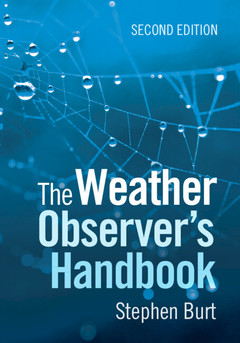The Weather Observer's Handbook (2nd Ed., Revised edition)
Langue : Anglais
Auteur : Burt Stephen

This handbook provides a comprehensive, practical, and independent guide to all aspects of making weather observations. The second edition has been fully updated throughout with new material, new instruments and technologies, and the latest reference and research materials. Traditional and modern weather instruments are covered, including how best to choose and to site a weather station, how to get the best out of your equipment, how to store and analyse your records and how to share your observations. The book's emphasis is on modern electronic instruments and automatic weather stations. It provides advice on replacing 'traditional' mercury-based thermometers and barometers with modern digital sensors, following implementation of the UN Minamata Convention outlawing mercury in the environment. The Weather Observer's Handbook will again prove to be an invaluable resource for both amateur observers choosing their first weather instruments and professional observers looking for a comprehensive and up-to-date guide.
Part I. The Basics: 1. Why measure the weather?; 2. Choosing a weather station; 3. Buying a weather station; Part II. Measuring the Weather: 4. Site and exposure – the basics; 5. Measuring the temperature of the air; 6. Measuring precipitation; 7. Measuring atmospheric pressure; 8. Measuring humidity; 9. Measuring wind speed and direction; 10. Measuring grass and earth temperatures; 11. Measuring sunshine and solar radiation; 12. Observing hours and time standards; 13. Aws data flows, display and storage; 14. Non-instrumental weather observing; 15. Calibration; 16. Metadata – what is it, and why is it important?; Part III. Making the Most of Your Observations: 17. Collecting and storing data; 18. Making the data avalanche work for you; 19. Sharing your observations; 20. Summary and getting started; Appendix 1: Metrology and meteorology: an instrument theory primer; Appendix 2: Recommended products; Appendix 3: Useful sources; Appendix 4: Mercury-based legacy thermometers and barometers; Appendix 5: Useful functions; Appendix 6: Unit conversions; References; Further reading; Index.
Dr Stephen Burt commenced his professional career in meteorology within the UK Met Office in 1977, followed by a series of private-sector marketing roles within the computer industry before returning to academia, eventually retiring from the Department of Meteorology at the University of Reading in 2018 (where he remains a Visiting Fellow). His meteorological research interests span instruments, observation techniques and methods, climatological data rescue, case studies of notable weather events, and long weather records and their sites; in all, he has authored or joint-authored some fifty peer-reviewed journal papers to date, and four other books. Stephen is a Fellow of the UK's Royal Meteorological Society and a member of both the American Meteorological Society and the Irish Meteorological Society. He is also an accomplished photographer with several hundred published photographs to his name.
Date de parution : 04-2024
Ouvrage de 522 p.
Date de parution : 04-2024
Disponible chez l'éditeur (délai d'approvisionnement : 14 jours).
Prix indicatif 115,29 €
Ajouter au panierThème de The Weather Observer's Handbook :
© 2024 LAVOISIER S.A.S.



